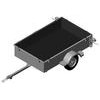Trailer Light and Reflector Requirements
- Read more about Trailer Light and Reflector Requirements
- Log in to post comments
 Nine lamps and six reflectors are the minimum required by law to be installed and functional on your trailer. If that trailer is not a small one, the number grows rapidly to stay in compliance depending on its length and width. Not just any lamp or reflector will do either, they all must be the right device for the right place and comply with standards.
Nine lamps and six reflectors are the minimum required by law to be installed and functional on your trailer. If that trailer is not a small one, the number grows rapidly to stay in compliance depending on its length and width. Not just any lamp or reflector will do either, they all must be the right device for the right place and comply with standards.

 The University of British Columbia's
The University of British Columbia's  QUESTION: I have a question/concern about horse carriages in a very busy downtown area and at a very busy intersection blocking the pedestrian crossing, forcing pedestrians to walk around the horse and into the traffic. The same issue exists for the bike lanes. The horse carriages routinely use the bike lanes and cyclists are forced out of the designated lane into the car traffic to get around the carriage. I have also witnessed the horse carriages stopping traffic in all three directions while they make a u-turn in the intersection.
QUESTION: I have a question/concern about horse carriages in a very busy downtown area and at a very busy intersection blocking the pedestrian crossing, forcing pedestrians to walk around the horse and into the traffic. The same issue exists for the bike lanes. The horse carriages routinely use the bike lanes and cyclists are forced out of the designated lane into the car traffic to get around the carriage. I have also witnessed the horse carriages stopping traffic in all three directions while they make a u-turn in the intersection. A visitor to this website remarked that the term "school days" in relation to school zone signs is becoming more and more ambiguous. The Motor Vehicle Act merely refers to "A person driving a vehicle on a regular school day" and I no longer know what a regular school day is, particularly since I don't have kids in school and when I am in an unfamiliar area of the province..
A visitor to this website remarked that the term "school days" in relation to school zone signs is becoming more and more ambiguous. The Motor Vehicle Act merely refers to "A person driving a vehicle on a regular school day" and I no longer know what a regular school day is, particularly since I don't have kids in school and when I am in an unfamiliar area of the province.. "The Ministry builds and maintains safe and resilient roadways and infrastructure, plans integrated transportation hubs and networks, provides affordable, efficient and accessible transportation options for all people in British Columbia, partners with Crown corporations and other entities to deliver transportation services, develops and implements transportation policies, and administers many related acts, regulations and federal-provincial funding programs."
"The Ministry builds and maintains safe and resilient roadways and infrastructure, plans integrated transportation hubs and networks, provides affordable, efficient and accessible transportation options for all people in British Columbia, partners with Crown corporations and other entities to deliver transportation services, develops and implements transportation policies, and administers many related acts, regulations and federal-provincial funding programs." The case of
The case of  Here's another question from the
Here's another question from the  Rose Keith of the
Rose Keith of the 
 I always thought that the disaster route signs posted beside some of our highways indicated the route that people would take if they had to evacuate during a disaster or major emergency. I was mistaken in my belief as these signs actually indicate routes that may only be used by emergency services consisting of police, fire, ambulance and other qualified responders.
I always thought that the disaster route signs posted beside some of our highways indicated the route that people would take if they had to evacuate during a disaster or major emergency. I was mistaken in my belief as these signs actually indicate routes that may only be used by emergency services consisting of police, fire, ambulance and other qualified responders.